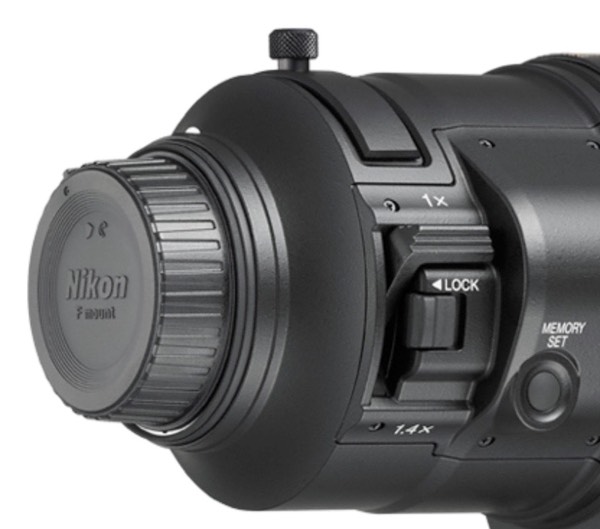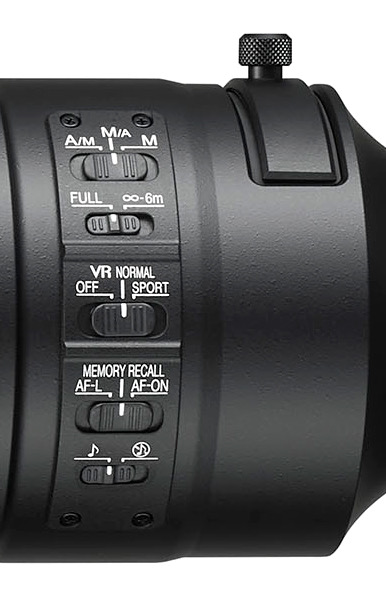
What is It?
The 180-400mm f/4E FL ED VR AF-S is a follow-up to a venerable lens with a long past (all the way back into manual focus days). It's Nikon's pro zoom optic that naturally sits above the f/2.8 pro zoom trio (14-24mm, 24-70mm, 70-200mm). While not an f/2.8 lens, the 180-400mm (and the 200-400mm before it) provide pro quality optics with the usual modest zoom range (~2x) in a package that easily be carried in the field with the other three.
To a large degree, the 2x zooms are "convenience and flexibility with quality." If you were trying to put a full set of quality optics using only primes, you'd end up with 14mm, 20mm, 24mm, 28mm, 35mm, 50mm, 85mm, 105mm, 180mm, 300mm, and 400mm lenses, or a total of 11 lenses you'd need to carry.
Why do pros like zooms? Well, we're not always allowed to move our position relative to a subject. Likewise, we sometimes want to shoot with a fixed (or non-changing) perspective so as not to emphasize it one way or another. In photojournalism, for example, you could shoot with one lens and constantly move your position (and thus perspective), but at some point that starts to become more about the style and cleverness of the photographer than it does about capturing what the subject is doing.
The original AF-S version of the 200-400mm f/4 was introduced in 2003 at the start of the D2 era, while the updated version (II) came out in 2010 in the D4 era. I've reviewed both those lenses, with my general conclusion being they were excellent lenses, but only up to modest subject distances. Up close they were astonishing clear and optically excellent, but as you got nearer to infinity, they tended to be weak.
When Canon came out with their 200-400mm f/4 with a built-in 1.4x teleconverter in 2013, the Nikon crowd was envious. Not only was the Canon version a very good lens that didn't have the "infinity problem", but it was a more flexible lens due to that built in teleconverter.
So here it is eight years after the last Nikkor update and five years after Canon and we finally have Nikon's answer: the 180-400mm f/4E FL TC1.4. There are a bunch of things to note just in the name.
First, Nikon has put a little more "wide" into the wide end. 20mm in a telephoto may not seem like a lot, but one of the reasons why you buy this lens is for flexibility in covering sports and nature, no matter how close or far you are. I was a bit surprised to find that the 180mm bottom did indeed provide something useful when working with closer or larger subjects. The actual number is 13°40' compared to 12°20', but that one degree difference was sometimes appreciated. So don't discount that little bit of un-reach: there will definitely come times when you'll like being able to zoom back out a bit more.

At the other end Nikon has added a flip-in 1.4x teleconverter that's matched to the optics of the lens. This provides you two "modes" for the lens: 180-400mm f/4, and 252-560mm f/5.6. There's a lock slider below the flip lever, but unlocked you'll find it very natural to just take your right index finger off the shutter release and flip the lever down to get the teleconverter in place. Because the lever is so convenient and becomes second nature quite fast, I tend to just think of this lens as a 180-560mm f/4-5.6 zoom.
I mentioned matched optics; there's a lot of optics. A whopping 27 elements in 19 groups, plus another 8 elements in 5 groups when the TC is flipped into place. Yeah, that's 35 elements in 24 groups, which has to set some kind of new record for zooms.
The FL in the name means there's a lightweight fluorite element inside to try to keep weight down. We also get a whopping 8 ED elements to reduce chromatic aberration, plus both Super Integrated and Nano coatings to reduce flare and ghosting. A drop-in 40.5 filter slot is provided with a clear filter (all part of that complex optical formula, baby).
Maximum aperture is f/4 and minimum aperture is f/32 without the TC (f/5.6 and f/45 with). The aperture is electronically controlled (an E-type lens), which means I have to point out that only D3 and later cameras are compatible: that would be the D3 series, D4 series, D5, Df, D300 series, D500, D600 series, D700, D750, D8xx series, D3100 and up, D5000 and up, and D7000 and up. Nikon also lists the Nikon 1 cameras as being compatible with the FT-1 adapter, and while they don't list it on their Web page at present, it also includes the Z6 and Z7 with the FTZ Adapter.
Close focus is a pretty nice 6.6 feet (2m). That provides a 1:4 magnification ratio at 400mm, and a "near macro" 1:2.8 at 560mm. I used the word "flexible" before; the close focus distance definitely extends the versatility for this lens.

Vibration reduction is quoted at 4-stops CIPA, and has the now-usual Off/Normal/Sport settings of recent exotics and telephotos. Nikon also provides A/M M/A M, Full/Limiter, Memory Recall, and Beep switches, plus we get the usual four Lens Fn/Recall buttons scattered up front of the zoom ring. By the way, the focus ring is the one closest to the camera, with zoom ring up at the front of the lens.
The lens has moisture and dust resistant design, with plenty of sealing around the controls.
Nikon now seems to think we need to know what lens is on our camera, as they put a very large 180-400mm stencil on the rotating mount that supports the removable tripod support handle (the 500mm f/5.6E PF also has its ID writ large on the rotating mount). Unlike previous such handles, Nikon finally has gotten around to making it "hand friendly" in overall shape, added extra relief to the lens itself, and included a textured material right where you'd be holding the lens via the handle. Alas, Nikon still hasn't gotten the Arca-Swiss memo, so we'll all up end up replacing what Nikon gave us ;~(.
Weight is 7.7 pounds (3.5kg), and the lens is 14.2" long (363mm) and a wide 5" (128mm) in diameter. The HK-41 carbon fiber hood adds another few inches and a bit of diameter when in place.
The 180-400mm f/4E is made in Japan and retails for US$12,400. The lens comes with the CL-L2 soft case, a lens carrying strap, the HK-41 lens hood, and the LC-K103 slip-on lens cap.
Source of the Reviewed Lens: rental from Lens Rentals
How's it Handle?
Personally, I was hoping the FL designation would have taken a bit more weight out of the lens. The 500mm f/4E FL is lighter than the 180-400mm by almost 400g, which is significant when you're carrying a long lens all the time. The 180-400mm is also about 2" longer than the 500mm f/4E FL.
Sadly, it's all that glass inside, and not enough of it is FL. So the 180-400mm f/4E ends up handling a lot like my old 500mm f/4G (nearly identical weight, and the 500mm is about an 1" longer). If you're looking for lighter and smaller in an exotic, the 180-400mm isn't really it. Instead, you're getting—here's that word again—something more flexible.
Don't get me wrong. I handheld this lens for hours at a stretch. Okay, I let it down on my BlackRapid strap every now and then. Still, I'd judge it right on the margin for a handholdable lens. You can do it, but you won't like it ;~).
We still get the fiddly-but-light carbon fiber hood and the terrible Little Red Riding Hood bonnet for a lens cap. Apparently Nikon never had anyone rethink these accessories or look to see what those of us in the field are doing.
Tip: get the AquaTech ASCN-3 Soft Cap [advertiser link]. Originally designed for a different lens, this cap works fine on the 180-400mm f/4, too, and it saves you from Nikon's silly Little Red Riding Hood Bonnet fiasco. The big travel issue with the lens is what you do with the large carbon fiber lens hood. Reversing it on the lens and putting that in your bag means you're using a bigger backpack that might not fit in an overhead compartment. I actually have little slip on covers for the lens hood of each lens with big exotic hoods, and I stuff clothing or other items inside the hood before putting the covers on, then pack that in my checked luggage.
I didn't like the swap of the zoom and focus rings because I'm one of those that manually override the focus from time to time, and on a tripod or monopod my left hand is up top right where...doh...the zoom ring is. That means a change of hand position for me now when I want to roll focus. I'm also not sure why we have a rubber texture ring at the very front of the lens, because that doesn't rotate and if you reach out front while looking through the viewfinder, you may find it instead of the zoom ring. Fortunately, the more I shot with the lens, the less I did that.
The rest of the controls are pretty much as we want them, and the overall build quality is typical Nikon exotic robust.
How's it Perform?
Focus: Snappy and accurate. Exactly what you'd expect from the best Nikkors. Be careful to understand what your focus sensors do on your camera if you switch in the 1.4x teleconverter. With some of the Nikon cameras, you lose active sensors at smaller apertures. But, given that you are trying to use still active sensors, the f/5.6 focus performance was also snappy and accurate.

Sharpness: Wide open this is a sharp lens, right up there with the exotic primes. Moreover, that sharpness extends out towards the corners much further than you'd expect, allowing you to consider more off-center focus points (see images, above and below). There's no other conclusion to make other than this lens is at a level that justifies its cost. It's excellent wide open, and perhaps superb at f/5.6, as the corners pull in better. Best overall aperture is clearly f/5.6, though at the wide end f/8 is ever so slightly better.
Note that I've seen a lot of others testing this lens at what I'd call too-close distances (too close to minimum focus distance, which again is near a macro level of magnification). The lens does seem to lose a bit of corner sharpness as you focus at the minimum focus distance, so be careful of sharpness assessments that aren't being done at what is your likely shooting distance.

I've also seen that some have written that the 180-400mm f/4 is as good as the 400mm f/2.8. That assessment is a little tougher to understand than those writers imply. My 400mm f/2.8 is wicked sharp from f/2.8. It actually loses a bit of acuity as you stop down. Thus, I'd tend to say that the 400mm f/2.8 is still the long telephoto champion in terms of hair splitting (of feather featuring) sharpness. But yes, the 180-400mm at 400mm and f/4 is very, very close to the 400mm f/2.8 at f/4. Enough close that sample variations could get in the way of a better evaluation.
Switching in the 1.4x TC definitely takes some of that acuity away, and particularly in the corners, but I found the lens to still be impressively sharp in the central area at 560mm f/5.6 (wide open with the TC in position). I'd tend to say that it may even look a little better in the central region with the TC than the old 200-400mm f/4 did without a TC, particularly at longer distances. Again, stopping down a stop will give you everything the lens can provide (e.g. shoot at f/8 with the TC engaged).
The new lens also doesn't seem to have the "declines with distance" issue the older 200-400mm f/4 did. While infinity focus is a bit less impressive than 100m focus, the falloff I saw could be as much due to atmospheric conditions as anything else, so I discount it. On my telephone pole test behind the house, the further I got from the pole, the more the 180-400mm looked better than my 200-400mm II. What I don't see in the new lens is the results that the 200-400mm tended to produce (great <50m, decent 50-100m, poor >100m): the 180-400mm seems great at all distances I shot it at.
Vignetting: the lens clearly vignettes at all focal lengths on FX bodies, more so at 400mm than at 180mm, but enough so that you'll want to correct it at every focal length. Overall, it's almost a two-stop drop in the far corners at f/4, and still near a stop down at f/5.6. Curiously, the vignetting is a very rapid fall off only in the corners at 180mm, as opposed to a more long, diffused falloff to the corners at 400mm. Vignetting is probably the biggest flaw of the lens, if this can be said to be a flaw. (Note: make sure your camera has the most current lens conversion tables installed if you’re shooting JPEGs.)
On DX bodies, vignetting is ignorable at 180mm, and starting to get into the realm you might want to correct at 400mm.
With the TC, vignetting goes down to more ignorable levels, much like with a DX crop.
Chromatic aberration: extremely well controlled, and as with most of the recent Nikkor exotics, essentially ignorable.
Distortion: quick testing shows a very slight barrel distortion at 180mm, and a visible pin-cushion distortion of about 1% at 400mm. Curiously, the TC adds more pin-cushion distortion, enough so that it's visible at pretty much all focal lengths.
Final Words
Nikon's done an impressive job updating the old 200-400mm f/4. In almost every respect we've gotten a far better lens. We now have a bit more range at the wide end, a convenient and quick TC option at the long end, plus better optical performance across the board. The "fatal flaw" of the 200-400mm f/4—acuity at distance—is now gone. Corners are sharper, even wide open or with the TC invoked.
In essence, you should consider this a 180-560mm f/4-5.6 lens (and if you're using a D850 and select DX crop when you are shooting far objects, you're really all the way out to 840mm effective with ~20mp). This is an exceptionally good lens.
In some quick side-by-side shooting with the 200-500mm f/5.6E, the 180-400mm f/4 easily shows why it costs so much. As good as the 200-500mm f/5.6E is for its price—and it's one of my "bargain" lens picks—someone shooting a D850 is just going to see more detail, better resolved, and with fewer issues. Plus focus speed on the more expensive lens is what you'd expect: significantly faster, both to acquire and track.
The problem, of course, is that price. At US$12,400, this is one of Nikon's most expensive lenses and nearly 10x the price of the 200-500mm. At the same time, the 180-400mm f/4E is Nikon's most versatile long telephoto, which is I believe the reason why you buy it. I can see someone forgoing the 300mm f/2.8, 400mm f/2.8, 500mm f/4, and 600mm f/4 for this lens. Thus, if you're one of those with two (or more) of the Nikkor exotics, the 180-400mm f/4 could simplify your life considerably, and maybe even save you some weight in some travel situations.
I can see a quality-oriented Nikon DSLR shooter that's trying to minimize their lens set to a four-lens bag select the 14-24mm f/2.8G, 24-70mm f/2.8E, 70-200mm f/2.8E, and 180-400mm f/4E. That nets you 14-560mm in four really good lenses. Of course, that's a pretty heavy bag ;~).
Recommended (2018 to present)